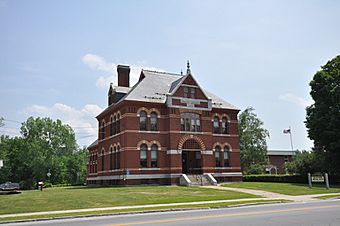Conant Public Library facts for kids
Quick facts for kids |
|
|
Conant Public Library
|
|
 |
|
| Location | 111 Main St., Winchester, New Hampshire |
|---|---|
| Area | 0.3 acres (0.12 ha) |
| Built | 1890 |
| Architect | Currier, J.M. |
| Architectural style | Romanesque, Victorian Romanesque Revival |
| NRHP reference No. | 87001420 |
| Added to NRHP | August 27, 1987 |
The Conant Public Library is a public library in Winchester, New Hampshire. You can find it at 111 Main Street. This beautiful building was built in 1891. It was paid for by Ezra Conant, who lived in Winchester and left money for it. The library's design is very special. It was created by J. M. Currier, an architect from Springfield, Massachusetts. He based it on another library he designed in Brattleboro, Vermont. The Conant Library is one of the most impressive buildings in Cheshire County. It was added to the National Register of Historic Places in 1987, which means it's an important historical site.
About the Conant Public Library
The Conant Public Library is located right in the center of Winchester. It stands just south of the town hall on Main Street. This building is made of red brick. It has special details made from granite and lighter-colored buff brick. The roof has a unique shape called a gable-on-hip roof.
Building Design and Features
The front of the library has a part that sticks out. This section has a gabled roof. The main entrance is set back under a large, rounded archway. On either side of this entrance, you'll see pairs of round-arch windows. These windows have granite sills. Their arches are made of alternating red and buff bricks. You can find similar windows on the sides and back of the building. Above the main entrance, there are four sash windows. These are topped by transom windows. They are shaped to form a wide, curved arch.
History of the Library
Winchester had an early library called the Washington Library Association. It was a private collection. In 1876, this group gave their books to the town. The collection was first kept in a business building on Main Street. However, this space was soon too small for all the books.
In 1889, Ezra Conant left a large sum of money to the town. He was born in Winchester. He became very wealthy in the leather business. He left $50,000 to pay for a new library building. This was a lot of money back then! His gift had one condition. The new library had to be a separate building. It could not be part of the town hall. The town had planned to include a library space in the town hall. The new library building was mostly finished in 1891. It officially opened its doors in April 1892.



